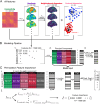A comparative machine learning study of schizophrenia biomarkers derived from functional connectivity
- PMID: 39843572
- PMCID: PMC11754439
- DOI: 10.1038/s41598-024-84152-2
A comparative machine learning study of schizophrenia biomarkers derived from functional connectivity
Abstract
Functional connectivity holds promise as a biomarker of schizophrenia. Yet, the high dimensionality of predictive models trained on functional connectomes, combined with small sample sizes in clinical research, increases the risk of overfitting. Recently, low-dimensional representations of the connectome such as macroscale cortical gradients and gradient dispersion have been proposed, with studies noting consistent gradient and dispersion differences in psychiatric conditions. However, it is unknown which of these derived measures has the highest predictive capacity and how they compare to raw functional connectivity specifically in the case of schizophrenia. Our study evaluates which connectome features derived from resting state functional MRI - functional connectivity, gradients, or gradient dispersion - best identify schizophrenia. To this end, we leveraged data of 936 individuals from three large open-access datasets: COBRE, LA5c, and SRPBS-1600. We developed a pipeline which allows us to aggregate over a million different features and assess their predictive potential in a single, computationally efficient experiment. We selected top 1% of features with the largest permutation feature importance and trained 13 classifiers on them using 10-fold cross-validation. Our findings indicate that functional connectivity outperforms its low-dimensional derivatives such as cortical gradients and gradient dispersion in identifying schizophrenia (Mann-Whitney test conducted on test accuracy: connectivity vs. 1st gradient: U = 142, p < 0.003; connectivity vs. neighborhood dispersion: U = 141, p = 0.004). Additionally, we demonstrated that the edges which contribute the most to classification performance are the ones connecting primary sensory regions. Functional connectivity within the primary sensory regions showed the highest discrimination capabilities between subjects with schizophrenia and neurotypical controls. These findings along with the feature selection pipeline proposed here will facilitate future inquiries into the prediction of schizophrenia subtypes and transdiagnostic phenomena.
© 2025. The Author(s).
Conflict of interest statement
Declarations. Competing interests: The authors declare no competing interests.
Figures






Similar articles
-
NBS-Predict: A prediction-based extension of the network-based statistic.Neuroimage. 2021 Dec 1;244:118625. doi: 10.1016/j.neuroimage.2021.118625. Epub 2021 Oct 2. Neuroimage. 2021. PMID: 34610435
-
Consistent Functional Connectivity Alterations in Schizophrenia Spectrum Disorder: A Multisite Study.Schizophr Bull. 2017 Jul 1;43(4):914-924. doi: 10.1093/schbul/sbw145. Schizophr Bull. 2017. PMID: 27872268 Free PMC article.
-
Multi-feature fusion method combining brain functional connectivity and graph theory for schizophrenia classification and neuroimaging markers screening.J Psychiatr Res. 2025 Mar;183:260-268. doi: 10.1016/j.jpsychires.2025.02.025. Epub 2025 Feb 21. J Psychiatr Res. 2025. PMID: 40010076
-
Task modulations and clinical manifestations in the brain functional connectome in 1615 fMRI datasets.Neuroimage. 2017 Feb 15;147:243-252. doi: 10.1016/j.neuroimage.2016.11.073. Epub 2016 Dec 1. Neuroimage. 2017. PMID: 27916665
-
Functional Connectivity Biomarkers in Schizophrenia.Adv Neurobiol. 2024;40:237-283. doi: 10.1007/978-3-031-69491-2_10. Adv Neurobiol. 2024. PMID: 39562448 Review.
Cited by
-
Individual uniqueness of connectivity gradients is driven by the complexity of the embedded networks and their dispersion.Brain Struct Funct. 2025 Jul 3;230(6):110. doi: 10.1007/s00429-025-02976-8. Brain Struct Funct. 2025. PMID: 40608110 Free PMC article.
-
Evaluating machine learning pipelines for multimodal neuroimaging in small cohorts: an ALS case study.Front Neuroinform. 2025 Jun 13;19:1568116. doi: 10.3389/fninf.2025.1568116. eCollection 2025. Front Neuroinform. 2025. PMID: 40586110 Free PMC article.
References
Publication types
MeSH terms
Substances
Grants and funding
LinkOut - more resources
Full Text Sources
Medical

